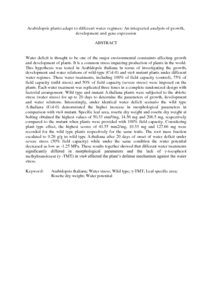Citation
Khalatbari , Amir Ali and Jaafar, Hawa Z. E. and Mahmood, Maziah and Othman, Radziah and Khalatbari, Amir Mahdi
(2015)
Arabidopsis plants adapt to different water regimes: an integrated analysis of growth, development and gene expression.
Journal of Food, Agriculture & Environment, 13 (1).
pp. 120-124.
ISSN 1459-0263
Abstract
Water deficit is thought to be one of the major environmental constraints affecting growth and development of plants. It is a common stress impairing production of plants in the world. This hypothesis was tested in Arabidopsis thaliana in terms of investigating the growth, development and water relations of wild-type (Col-0) and vte4 mutant plants under different water regimes. These water treatments, including 100% of field capacity (control), 75% of field capacity (mild stress) and 50% of field capacity (severe stress) were imposed on the plants. Each water treatment was replicated three times in a complete randomized design with factorial arrangement. Wild type and mutant A.thaliana plants were subjected to the abiotic stress (water stress) for up to 20 days to determine the parameters of growth, development and water relations. Interestingly, under identical water deficit scenario the wild type A.thaliana (Col-0) demonstrated the higher increase in morphological parameters in comparison with vte4 mutant. Specific leaf area, rosette dry weight and rosette dry weight at bolting obtained the highest values of 50.33 mm²/mg, 14.56 mg and 206.5 mg, respectively compared to the mutant when plants were provided with 100% field capacity. Considering plant type effect, the highest scores of 41.55 mm2/mg, 10.33 mg and 127.66 mg were recorded for the wild type plants respectively for the same traits. The root mass fraction escalated to 0.26 g/g in wild type A.thaliana after 20 days of onset of water deficit under severe stress (50% field capacity) while under the same condition the water potential decreased as low as -1.25 MPa. These results together showed that different water treatments significantly differed in morphological parameters and the lack of γ-tocopherol methyltransferase (γ -TMT) in vte4 affected the plant’s defense mechanism against the water stress.
Download File
![[img]](http://psasir.upm.edu.my/43828/1.hassmallThumbnailVersion/Arabidopsis%20plants%20adapt%20to%20different%20water%20regimes%20An%20integrated%20analysis%20of%20growth%2C%20.pdf)  Preview |
|
PDF (Abstract)
Arabidopsis plants adapt to different water regimes An integrated analysis of growth, .pdf
Download (106kB)
| Preview
|
|
Additional Metadata
Actions (login required)
 |
View Item |

